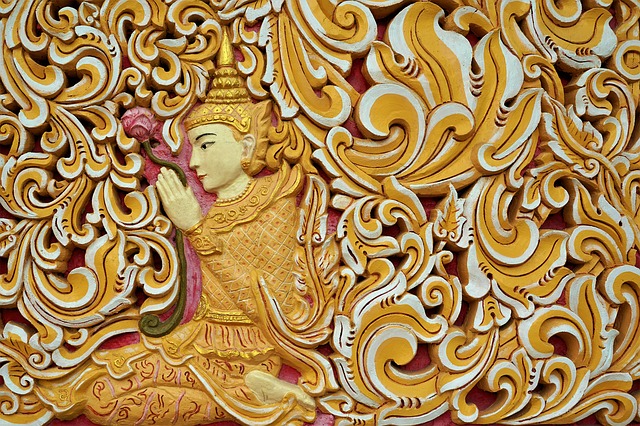The Buddha Meets Adam and Eve

The story of Adam and Eve in the Garden of Eden and the story of the enlightenment of the Buddha are two of the most famous in the history of religion. Not only that, but even though they arose in different cultures they seem to say the same thing. And what they say resonates with us, no matter our time, no matter our place.
Beginning with the biblical narrative, there they are, the original pair, happily enjoying life in the garden created for them by the god Yahweh. Only one fruit is forbidden to them, and that fruit is of the tree of the “knowledge of good and evil”, a phrase in Hebrew that refers to all knowledge of everything, top to bottom, left to right, good to evil. It connotes not a moral awareness but rather all knowledge. Total knowledge of course is impossible, so the prohibition is a warning not to act as if you knew everything, a prohibition not to create your egocentric world, not to create a filter through which you strain and contort reality to suit your own needs. Of course, there is no god walking around in the garden who has issued such an order. The prohibition, therefore, represents Adam and Eve’s- our- existential awareness that egocentricity is not right, that the world we create for ourself shades the truth. As a consequence, the natural order of life is disrupted. Adam blames Eve and she blames the serpent. The pair is exiled, and an angel with a flaming sword is stationed at the gate to the garden, preventing the pair from ever returning and eating of the tree of life, a sure sign that total happiness and harmony is no longer a viable option for human beings. Something is missing. Unrestrained egocentricity prevents experiencing the fullness of life and instead we experience an emptiness and a longing. That’s what the story tells: believing and acting in accordance with the distorted world-view we have created for ourself leads to the sense that something is wrong, as indeed there is.
As the story goes, Siddhartha Gautama, Buddha-to-be, was a young prince isolated and protected from the world by his father. Then on different occasions, he sees outside, in turn, a sick person, an old person, a corpse, and a monk, becoming aware of these truths of human life for the first time. Although he later marries and has a child, the search for meaning and enlightenment overpowers the young man, and he sets out on a life journey, fails to find satisfaction in various religious traditions, and finally, sitting under a bodhi tree, the answer comes. Summarized in his first sermon as “the four noble truths”, Buddha had discovered the path to enlightenment.
The first truth, which seemed true simply by observing life, is that life is suffering, and the second is that the cause of suffering is desire. The third is that there is a way to overcome desire and suffering, and the fourth truth outlines the conditions for that to happen. Suffering and desire. What do these mean?
On the first, according to noted Buddhist scholar and psychologist Rick Hanson, in addition to physical and social pain, suffering “… includes the subtlest qualities of tension in the mind, restlessness, sense of contraction, preoccupation, unease, boredom, blahness, ennui, sense of being an isolated self, something missing in life, something just not fulfilling, etc.” [rickhanson.net]
And on the second: “The bad news is that we suffer. The good news is that there is a prime cause – clinging – that we can address. There are lots of words that get at different aspects of clinging. For example, the original Pali word is “tanha,” the root meaning of which is thirst. Here are some related words, and you might like to pause briefly after each one to get a sense of the experience of it: Desire. Attachment. Striving. Wanting. Craving. Grasping. Stuck. Righteous. Positional. Searching. Seeking. Addicted. Obsessed. Needing. Hunger.
… one of the three fundamental characteristics of existence is impermanence. Everything changes. Nothing of mind or matter lasts forever. Every single moment changes instantly into something else. That’s the absolutely universal nature of outer reality and of inner experience. But what is the nature of the human mind? The mind evolved to help us survive, and it does so by trying to figure out stable patterns in the world, and in our life, and to develop lasting solutions to life’s problems. As a result, our mind is forever chasing after moments of experience or moments of reality — trying to hold on to them to understand them, to get a grip on them, to control them. At the most basic, microscopic level, it is the nature of mind to cling.” [ibid.]
The parallels between the Hebrew and Buddhist understandings are striking. Life is suffering, says the Buddha. As we have seen from Hanson, in addition to physical and social pain, there is the psychological dimension described as the feeling that something is missing in life, that the meaning is not there. The Yahwist also observes that life is suffering. There is the physical, of course, epitomized by the hardship of survival and the pain of childbirth, and there is the social disorder signified by the blame game. But beyond these, the fact is that the couple are aware that what they have become is not what they were created to be. Utilizing non-mythological language, they are aware that something is not quite right in life, that they are living a denial of their true humanity.
And the cause of suffering is clinging.The mind, according to Hanson, has evolved to find interpretive patterns by means of which we order reality, chasing impermanent moments with a mind that does not want to change, one that clings to the structure it has created. We impose the world we have created on the fleeting real world, clinging to our falsehood, and the result is that we suffer. Likewise the Yahwist. The forbidden fruit is the existential situation in which all of reality is forced to conform to the interpretive framework imposed by your mind. Of course, you do not know everything, but everything that you come to know is filtered through the interpretive framework created by your mind. This is a filter to which one clings.
Whether from the Buddhist or Hebrew perspective, the following description of human nature emerges. As each of us develops in this world, we are bombarded with sensation and thoughts, leading us to create a mental system of interpretation into which we throw the incoming information and through which we interpret that information. We have a framework through which we interpret reality, and my framework is different from yours. We share some perspective, but not all. Buried beneath the false certainty of this created world is the sense that something is not quite right. At some level we realize that we are blind to the Reality that surrounds us, that we live in a void devoid of ultimate meaning.
How to go beyond suffering and desire, re-enter the garden and find the tree of life, is the challenge confronting us all. We’ll look at that next time.

